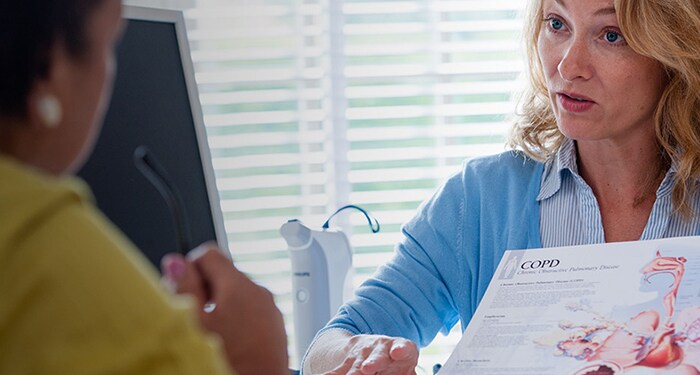Deepen your
Mental health focus
to elevate care
When you overlook the mental health component of COPD care, you may only be addressing surface issues. Keep patients living healthy at home by putting mental health services at the core of your care.
You do a lot to manage patients with COPD. You carefully assess their symptoms, family history, exacerbations, medications, devices, compliance, etc. You even test for common respiratory comorbidities. While these measures are vital to quality care, accounting only for them may be leaving quality on the table. Treating respiratory conditions alone accounts for the what, but not the why. For instance, why is a patient smoking so much? Why is he failing to be adherent with therapy? Why is he skipping medical appointments? Questions like these point to a deeper treatment opportunity.
Treating deeper
Your patients’ needs go far beneath the surface of COPD symptom control. To fully care for these people, your team may need to identify the root cause of their issues. This means looking past medical and technical considerations and focusing on social and mental ones. After all, you’re not just treating a person with COPD—you’re treating a person with a broad health profile. And this person may have mental health considerations, along with far deeper needs.
One thing we’re missing with our COPD population is the concurrent mental health pathology.”
-Jill Ohar, MD, FCCP
Professor of Internal Medicine, Pulmonary, Critical Care, Allergy, and Immunological DiseasesWake Forest University School of Medicine
Director of Clinical Operations
Wake Forest University Baptist Medical Center
Contributors
Data you can’t ignore
22%of COPD patients
have a coexisting psychological disorder1
Data you can’t ignore
28%of smokers with depression
smoke more than 1 pack per day (vs 15% of non-depressed smokers)2
Data you can’t ignore
Depressed individuals are more likely to have a cigarette
within 5 minutes of waking2
Data you can’t ignore

COPD patients with depression are nearly
Three Times more likely
to be readmitted within one year3
Jill Ohar explains, “We have a very, very high concurrent burden of mental health pathology. Now there are emerging data on why people come back and why they don’t take their drugs. We end up having a whole crop of COPD patients who have depression, bipolar, schizophrenia—who are untreated.” These patients may have childhood trauma, unresolved issues, or even just a lack of basic human necessities: meals, a safe and clean environment, or personal support, for example. Despite your greatest efforts, missing opportunities to treat these concerns can leave your patients at higher risk of ongoing issues. Ohar believes this raises the risk of patients becoming recalcitrant, continuously relying on a substance like tobacco and not taking their medicine. And what comes next? Readmissions—and all the costly consequences. Dr. Ohar speculates, “If we treat the mental aspect of their condition, one would wonder if that would be very helpful to our readmission rate, our non-adherence rates, et cetera.”
On expanding your focus
We are treating whole people, not just their body parts. Mental health issues, like depression and anxiety, are a huge part of the comorbid condition of COPD."
-Jill Ohar, MD, FCCP
Professor of Internal Medicine, Pulmonary, Critical Care, Allergy, and Immunological Diseases Wake Forest University School of Medicine Director of Clinical Operations Wake Forest University Baptist Medical Center
Psych up your care team
Treating deeper issues requires a more specialized care team. Be inspired to complement your COPD experts with these two members.
Psychiatrist/psychologist
Help analyze your patient to identify the root causes of behaviors that are counterproductive to care
Social worker
Key to identifying basic human needs and helping patients connect to community services
On supporting basic human needs
Deeper care drives longitudinal care (and accountable care)
A key goal of your COPD care team overlaps greatly with a goal of accountable care organizations (ACOs)—maximize the quality of care while minimizing the cost of it. Adopting a mental health focus strongly supports this goal. This means taking a proactive approach and addressing critical issues before they derail treatment success. Les Duncan explains, “Behavioral health is a huge issue. If you look at ED visitation for example, a large percentage of the people that are frequent flyers in the ED have behavioral health issues. One reason is because that's their social outlet. ‘I’m going to go to the ED because someone’s going to be there that's going to care about me. They are going to feed me and I’m going to have a nice place to sleep for a night.’”
Invest in savings
Les Duncan highlights that, in order to save long-term costs, you should be investing more in quality care up front. Here are 3 examples you can start implementing today.
Homecare visits
that can ensure patients’ basic needs are met
Medication delivery services
for antidepressants or antipsychotics, in addition to meds for COPD
Patient risk stratification
to shed light on effective, personalized care
We don’t just want to take care of the patient when they show up with an illness, but rather throughout the continuum of their life. That’s how we take a longitudinal approach. That’s how population health programs work.”
-Les Duncan
Director of Operations Highmark–Community and Health Services
Thinking beyond single episodes of care can enable you to treat patients more holistically. This may help you create better wellness today and maintain it long-term. It is the nucleus of accountable care and drives better outcomes all around.
Shift the paradigm
Value-based care is here to stay. You can create better value in COPD treatment by partnering with your patients, deeply considering their total picture of health, and delivering care that gets them home and keeps them home. If you are concerned that you won’t be reimbursed for your mental health services, don’t be. On the back end, enhancing patient care will pay for itself, and so much more.
Don’t be afraid to do work for which you can’t charge.”
-Becky Anderson, RRT
Manager, Respiratory Care Services Sanford Medical Center
Think past surface-level symptoms. Employ experts to address deeper mental health issues. And open up extraordinary possibilities for care today.
Case study: Stopping readmissions by addressing anxiety
Jill Ohar, MD, FCCP
Professor of Internal Medicine, Pulmonary, Critical Care, Allergy, and Immunological Diseases Wake Forest University School of Medicine Director of Clinical Operations Wake Forest University Baptist Medical Center
References: 1. Singh G, Zhang W, Kuo YF, Sharma G. Association of psychological disorders with 30-day readmission rates in patients with COPD. Chest. 2016;149(4):905-915. 2. Pratt LA, Brody DJ. Depression and smoking in the U.S. household population aged 20 and over, 2005-2008. NCHS Data Brief. 2010;(34):1-8. 3. Iyer AS, Bhatt SP, Garner JJ, et al. Depression is associated with readmission for acute exacerbation of chronic obstructive pulmonary disease. Ann Am Thorac Soc. 2016;13(2):197-203.













